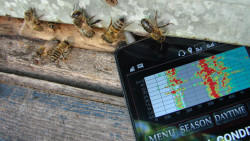General signal level of the bee society during the day, its meaning, and the features of its changes during the day.
General signal level of the bee society varies during the day, and has its own, highly pronounced rhythms, related to honey collection. Stronger peaks of signals, are observed early in the morning, and may precede the onset of honey collecting activity, for a few hours . Most of these morning signals are produced by foragers , which were very successful in the past day! Thus, we can say, that the large size of morning peaks means a good honey harvest in the previous days, and reliable for a good honey harvest in this day. This is logical... success in honey collection in the prior day, and good reserves of nectar found by foragers, which become known to all the bees after the morning "meeting", and with the successful combination of the weather and the activity of the bees, leads to increment of volume of daytime negotiations, related to the delivery, and reloading of nectar, and accordingly, to the increment of the work on the evening processing of previously brought nectar. Evening peak can also be quite large, and its size directly related to the success of present day honey collection. Signalers activity usually increases in the evening, when honey collection activity decreased, but the honey processing and care of the brood, must continue. This is supported by a wide variety of feedback signals from recipients. Using Apivox Auditor in the Monitoring mode, you can see the increase of amplitude of background signal components. You receive a lot of narrow peaks in almost all signal range. This means the small number of bees in groups, and the fragmentation of groups of bees, which create this peaks. After that, they "gather" in the new groups, creating on the Monitoring mode screen, new signals of greater intensity, which means that some bees changed their activities, and joined to another working group. Theory and experiments of American scientists agrees completely with our own observations, and recommendations that we give to those, who will use APIVOX AUDITOR in their daily practice. Our main recommendation states, that if you want to know the general status of the bee society, then it is the best to do it as close to the peak of flight activity of bees, as possible. At this time, the work should be the of most intense as it is possible. Passive bees should be in the minimal amount. This time period, very well characterize todays honey harvest . If you want to know possible information about the previous day, was honey harvest good or bad, and whether there is a hope for the continuation of good honey harvest, then you can get the local information when measuring from seven to nine in the morning. Of course, time of measurement depends on the weather. It can be determined experimentally for your region. Evening measurements during the time, beginning from reduction and to the complete absence of flight activity, from sixteen to nineteen hours, will give you a rough understanding of the results of the today's working day. Local data that you get during this time, will determine the amount of supposed by the bees works, for evening and night time. Night measurements, made from top of the frames with combs through the textile lap, taking into account the duration of the time interval which has elapsed, since the termination of flights of bees, will help you to understand the volume of remained honey, which is the subject for further processing and storage. The longer busyness of the bees with intensive honey processing, the greater was their today's "prey".
Keywords
beekeeping, apicultura
Countries
Austria, Australia, Germany, Spain, France, United Kingdom, United States

